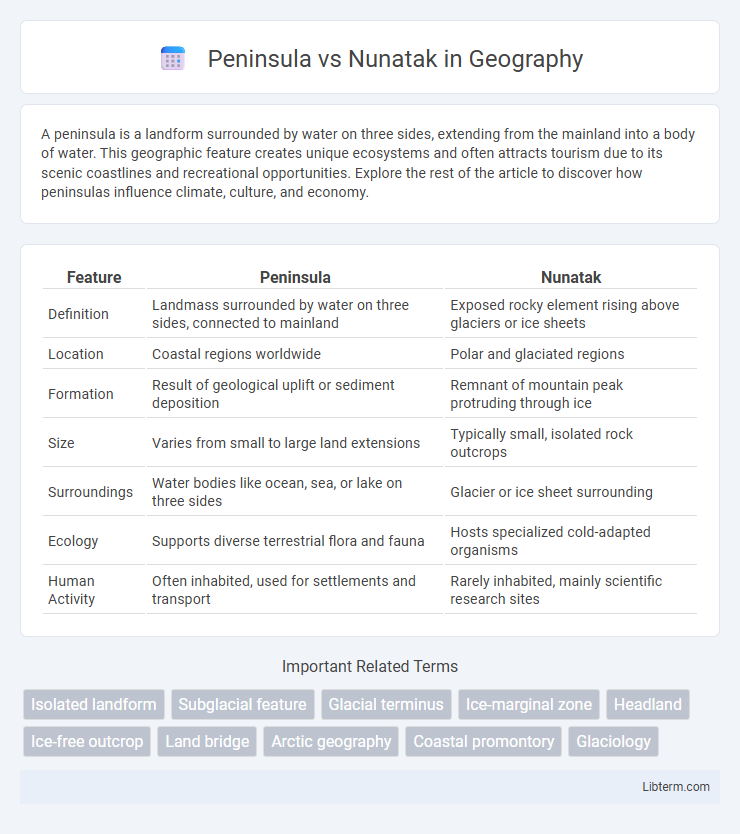A peninsula is a landform surrounded by water on three sides, extending from the mainland into a body of water. This geographic feature creates unique ecosystems and often attracts tourism due to its scenic coastlines and recreational opportunities. Explore the rest of the article to discover how peninsulas influence climate, culture, and economy.
Table of Comparison
| Feature | Peninsula | Nunatak |
|---|---|---|
| Definition | Landmass surrounded by water on three sides, connected to mainland | Exposed rocky element rising above glaciers or ice sheets |
| Location | Coastal regions worldwide | Polar and glaciated regions |
| Formation | Result of geological uplift or sediment deposition | Remnant of mountain peak protruding through ice |
| Size | Varies from small to large land extensions | Typically small, isolated rock outcrops |
| Surroundings | Water bodies like ocean, sea, or lake on three sides | Glacier or ice sheet surrounding |
| Ecology | Supports diverse terrestrial flora and fauna | Hosts specialized cold-adapted organisms |
| Human Activity | Often inhabited, used for settlements and transport | Rarely inhabited, mainly scientific research sites |
Introduction to Peninsulas and Nunataks
Peninsulas are landforms surrounded by water on three sides, extending from the mainland into a body of water such as an ocean, sea, or lake, often influencing coastal ecosystems and human settlement patterns. Nunataks are exposed, rocky peaks or ridges that protrude above ice sheets or glaciers in polar regions, serving as isolated habitats and geological markers within glacial areas. Both features play significant roles in physical geography, highlighting interactions between land and surrounding environmental elements.
Geological Definitions: Peninsula vs Nunatak
A peninsula is a landform projecting into a body of water, connected to the mainland by an isthmus, characterized by its extension of terrestrial terrain surrounded primarily by water on three sides. A nunatak is a geological feature consisting of an exposed, often rocky peak or ridge that protrudes above an ice sheet or glacier, serving as an isolated outcrop in glaciated regions. While peninsulas connect continuously to larger landmasses, nunataks are surrounded by ice and represent remnants of pre-glacial landscapes or bedrock emergent from ice cover.
Formation Processes Compared
Peninsulas form through tectonic activity, sediment deposition, and erosion that extend landmasses into bodies of water, often resulting from the gradual accumulation of sediments or volcanic activity. Nunataks are exposed peaks or ridges that protrude above ice sheets or glaciers, formed by glacial erosion removing surrounding softer material while the harder rock resists erosion. The primary distinction in their formation processes lies in peninsulas developing from sedimentary or volcanic land growth into water, whereas nunataks result from glacial sculpting that isolates rocky outcrops amid ice.
Key Characteristics of Peninsulas
Peninsulas are landforms surrounded by water on three sides while remaining connected to a larger landmass, characterized by their narrow shape extending into a body of water such as an ocean, sea, or lake. Unlike nunataks, which are isolated mountain peaks protruding through ice fields or glaciers, peninsulas typically support diverse ecosystems and human settlements due to their accessible terrain. Key features include coastal boundaries, prominent shorelines, and strategic locations that influence climate and marine navigation.
Distinct Features of Nunataks
Nunataks are isolated, exposed rock peaks that protrude through ice fields or glaciers, serving as unique ecological islands amidst vast ice expanses. Unlike peninsulas, which are landforms extending into water and connected to larger landmasses, nunataks are completely surrounded by ice rather than water. Their prominent elevation above the ice surface provides critical refuges for plants and animals, offering insights into glacial geology and climate history.
Ecological Significance and Biodiversity
Peninsulas, extending from contiguous landmasses into water bodies, support diverse ecosystems with a mix of terrestrial and marine species, often serving as critical habitats for migratory birds and coastal flora. Nunataks, isolated mountain peaks protruding through glacial ice, provide unique ecological niches for specialized alpine and cold-adapted organisms, acting as refugia during glacial periods and maintaining genetic diversity. Both landforms contribute significantly to biodiversity, with peninsulas fostering rich coastal ecosystems and nunataks preserving rare, endemic species in extreme environments.
Examples Around the World
Peninsulas such as the Iberian Peninsula in Europe and the Florida Peninsula in the United States extend prominently into surrounding water bodies, creating distinct landforms bordered by three sides of water. Nunataks, exemplified by the Sentinel Range in Antarctica and the Greenland Ice Sheet's exposed peaks, are rocky mountain summits that protrude through glacial ice, serving as isolated habitats within ice-covered regions. These geographic features differ fundamentally in formation and context, with peninsulas connected to larger land masses and nunataks isolated within ice fields.
Human Activity and Settlement
Peninsulas support diverse human activities and settlements due to their access to marine resources and strategic locations for trade, fishing, and tourism, often hosting numerous towns and infrastructure. Nunataks, isolated rocky peaks protruding through ice fields in polar regions, experience minimal human presence primarily limited to scientific research stations and temporary expeditions. The harsh climatic conditions and remoteness of nunataks restrict permanent settlement and large-scale economic activities compared to the more accessible and hospitable environments of peninsulas.
Importance in Climate and Environmental Studies
Peninsulas and nunataks play crucial roles in climate and environmental studies by serving as natural indicators of glacial history and climate change. Peninsulas influence ocean currents and local climates, while nunataks, which are isolated peaks protruding through ice sheets, provide unique habitats and geological records essential for understanding ice sheet dynamics and past climatic conditions. Studying these landforms helps scientists track environmental shifts and predict future climate scenarios.
Conclusion: Distinguishing Landforms
A peninsula is a landform surrounded by water on three sides and connected to the mainland, promoting diverse ecosystems and human activities. In contrast, a nunatak is a rocky peak or ridge protruding above glaciers or ice sheets, often serving as isolated refuges for plant and animal species in polar regions. Understanding these distinctions aids in geological mapping, ecological studies, and climate change research.
Peninsula Infographic

 libterm.com
libterm.com